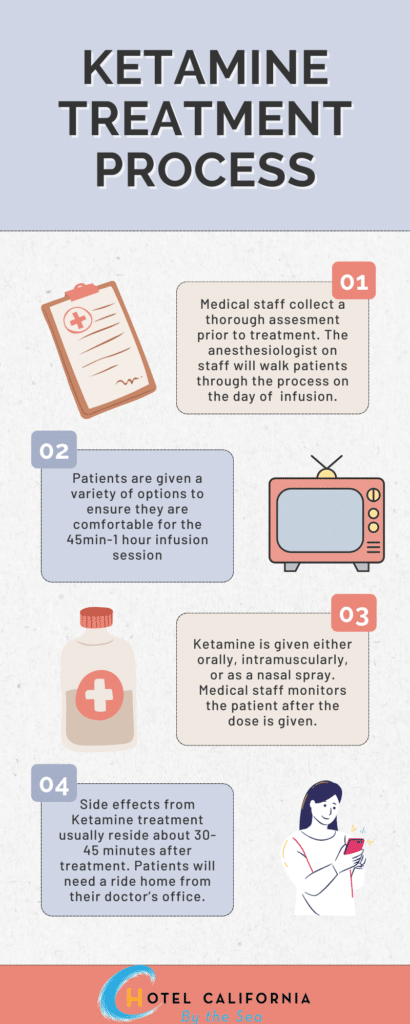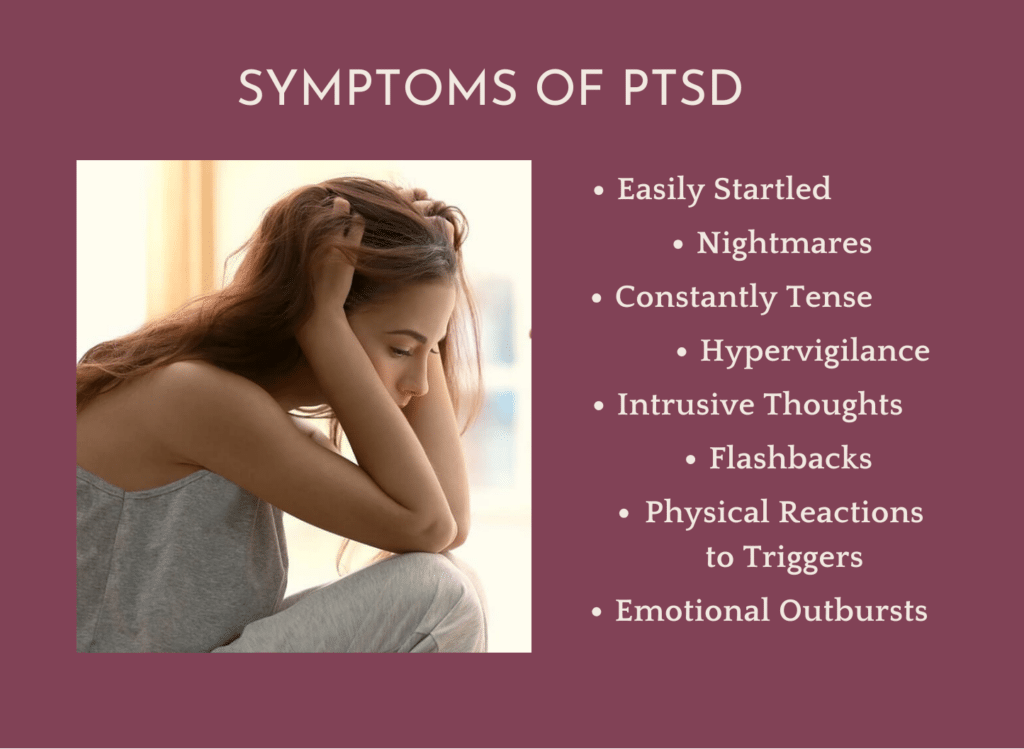Ketamine for PTSD
Ketamine is an anesthetic medication that can produce dissociative and hallucinogenic effects. When taken, it distorts the perception of sight, sound and touch. Ketamine can induce a state of sedation, intense relaxation and relief from pain. New research has found that ketamine treatment for post-traumatic stress disorder (PTSD) and other types of mood disorders has been proven effective in minimizing symptoms. Ketamine therapy can provide symptom relief from anxiety and treatment-resistant depression with minimal side effects.
Currently, antidepressants, cognitive behavioral therapies and other mood-enhancing prescription medications have the most evidence-based results in treating PTSD. These traditional routes of treatment only address the symptoms of PTSD. There is no cure. Drugs such as MDMA, magic mushrooms and ketamine are growing as a new generation of psychiatric medication used to help treat people experiencing chronic PTSD.

According to a study published by the American Journal of Psychiatry, the first randomized controlled trial of ketamine therapy treatment for chronic PTSD is yielding promising results. Research and data suggest that repeated intravenous ketamine therapy is a promising treatment for people who suffer from chronic PTSD. The first clinical trials for treating PTSD with ketamine therapy started in the 2000s and resulted in patients reporting symptom relief for up to 20 days after initial treatment.
This new data is now prompting future studies to understand the long-term responses to ketamine infusion therapy in treating mood disorders like PTSD, anxiety, and depression.
Ketamine for PTSD
What is ketamine treatment for PTSD? Ketamine infusion therapy is a fast-acting and non-invasive treatment option for treating those with symptoms of depression, anxiety and other mental health disorders. Ketamine infusion therapy is delivered intravenously in a clinical setting by medical professionals. Ketamine therapy is also available in a nasal spray form. Medical experts have found that ketamine therapy is a good alternative option for those patients who don’t respond well to traditional treatments such as antidepressants, CBT, and DBT. People who have treatment-resistant depression often turn to ketamine therapy.
How does ketamine work? Experts aren’t completely sure how ketamine works when it comes to treating mood disorders. However, a few potential factors play a role in the success of its treatment. Ketamine is a non-opioid anesthetic that works by blocking N-methyl-D-aspartate (NMDA) glutamate receptor activity in the brain. This receptor plays a major part in the central nervous system and affects functions such as memory and learning. When NMDA receptors are blocked, it can help reduce the symptoms of PTSD associated with traumatic memories and flashbacks of the distressing event. It helps balance the overactive neurotransmission pathway.

In other research, studies found ketamine helps increase the production of certain types of neurotransmitters such as serotonin and dopamine. Serotonin and dopamine are also known as “feel good” hormones as the reward system naturally produces them to encourage a specific behavior. These neurotransmitters are known to regulate mood and stress. Ketamine can reduce levels of fear and anxiety in patients with PTSD by increasing the “feel good” hormones.
Ketamine works to reduce inflammation in the brain, which also contributes to alleviating symptoms of depression and PTSD. In small doses, ketamine can produce relief by targeting certain overactive brain receptors and raising levels of dopamine and serotonin. In larger doses, ketamine can stimulate a state of intense relaxation and reduce pain sensitivity. Researchers have found the main benefit of ketamine for PTSD relies on immediate relief from anxious and depressive symptoms with minimal side effects.
Ketamine infusions showed signs of improvements in symptoms across three out of four PTSD diagnostic clusters: re-experiencing, avoidance, and negative cognitions and mood. The research found that improvement from ketamine therapy produced results as quickly as 24 hours after infusion and maintained for an average of 27 days after. Some notice improvements within a few hours. This is compared to other typical treatments for anxiety, depression and PTSD, which can take days, weeks or even months to take into effect.

What is Post Traumatic Stress Disorder?
Post-traumatic stress disorder is a type of anxiety disorder that can develop after a person has experienced a traumatic or distressing event. It’s natural to feel afraid or stressed during and after a traumatic experience. Fear is part of the body’s fight or flight response that helps us avoid danger. However, when these feelings and reactions continue to persist and the person does not recover from the event, they can be diagnosed with PTSD.
PTSD is the presence of reoccurring, intrusive, distressing memories, dreams and flashbacks, as well as reactions to a distressing event experienced. PTSD is associated with a high degree of disability and makes it difficult to maintain employment, social wellness and daily activities. An estimated 12 million Americans experience PTSD every year. According to the National Center for PTSD, six out of 100 people will experience PTSD at some point in their lives. Eight out of 100 women will develop PTSD. Three out of 100 men will develop PTSD. Women are more likely than men to develop PTSD.
To be diagnosed with PTSD, a person must exhibit symptoms for longer than one month and should be severe enough that it hinders aspects of daily life. Symptoms of PTSD usually develop within three months. There are four main categories of symptoms: re-experiencing, avoidance, arousal and reactivity, and cognition and mood.
Re-experiencing symptoms include flashbacks, recurring memories or dreams and physical signs of stress such as headache and muscle pain. Avoidance symptoms include staying away from certain places or people and avoiding specific thoughts and feelings associated with the distressing event. Arousal and reactivity symptoms include being startled easily, feeling tense and difficulty concentrating due to the feeling of always being on edge. Cognition and mood symptoms include having difficulty remembering, having negative thoughts, having ongoing negative emotions and loss of interest in activities once loved.
Check Your Insurance Coverage for FREE
Find out if your insurance covers addiction treatment in minutes. We accept most insurance!
Common Symptoms of PTSD
- Flashbacks
- Nightmares
- Numbing of emotions
- Increased anxiety and depression
- Hypervigilance
- Trouble sleeping
- Feelings of loneliness and detachment
- Frightening thoughts
- Difficulty concentrating
- Physical pain
- Avoidance of memories
- Negative belief about self and others
According to the DSM-5, PTSD has a high prevalence in military veterans, firefighters, police and emergency personnel. However, PTSD can affect anyone. Treatment for PTSD is very individualized. There are many contributing factors to the severity of the disease and the length of treatment needed. Examples of events that can cause the development of PTSD include war, combat fighting, car accidents, domestic abuse, sexual abuse, natural disasters and death.
Reach out to Hotel California by the Sea
We specialize in treating addiction and other co-occurring disorders, such as PTSD. Our Admissions specialists are available to walk you through the best options for treating your addiction.
Treatment for Post Traumatic Stress Disorder
Treatment for PTSD varies from person to person. Individual and environmental factors help determine the severity of the disease as well as what types of treatments can be effective. Selective serotonin reuptake inhibitors (SSRIs) such as anti-depressant medications, are traditionally the first option for treatment. It is the only pharmaceutically approved treatment to help reduce depressive symptoms of PTSD. In cases where this doesn’t work, some experts are turning to alternative methods such as ketamine infusion treatment therapy. Behavioral health treatment programs such as Hotel California by the Sea provide a wide range of options when it comes to the treatment of PTSD and other anxiety disorders.
Those who experience PTSD most often also experience a substance use disorder. In our substance use disorder program, we provide varying levels of care to help our clients overcome their mental health disorders as well as addiction. Detox, residential and outpatient programming are available to fit the needs of each client. Specialized therapies such as CBT and DBT help clients understand the main cause of their addiction and trauma. At Hotel California by the Sea, we are committed to helping our clients overcome their addictions, manage their mental health disorders and discover a new life in sobriety.
References:
https://www.ncbi.nlm.nih.gov/pmc/articles/PMC6457782/
https://ajp.psychiatryonline.org/doi/10.1176/appi.ajp.2020.20121677
https://www.klarityclinic.com/blog/understanding-the-science-behind-ketamine-treatment-for-ptsd
https://www.alliedpsychiatry.com/blog/i-have-ptsd-can-ketamine-therapy-help-relieve-my-anxiety
https://www.samhsa.gov/mental-health/post-traumatic-stress-disorder
https://adaa.org/understanding-anxiety/posttraumatic-stress-disorder-ptsd
https://www.dea.gov/sites/default/files/2020-06/Ketamine-2020.pdf
https://mindfulhealthsolutions.com/how-ketamine-infusion-therapy-is-helping-patients-with-ptsd-symptoms/
